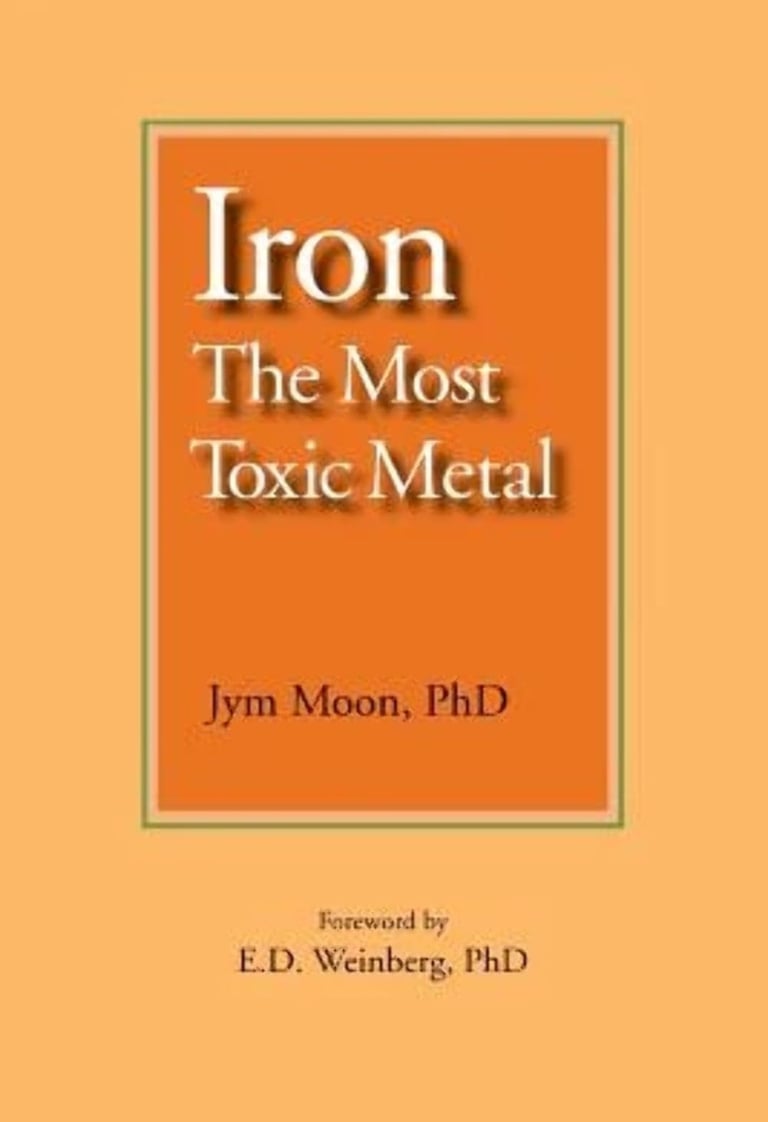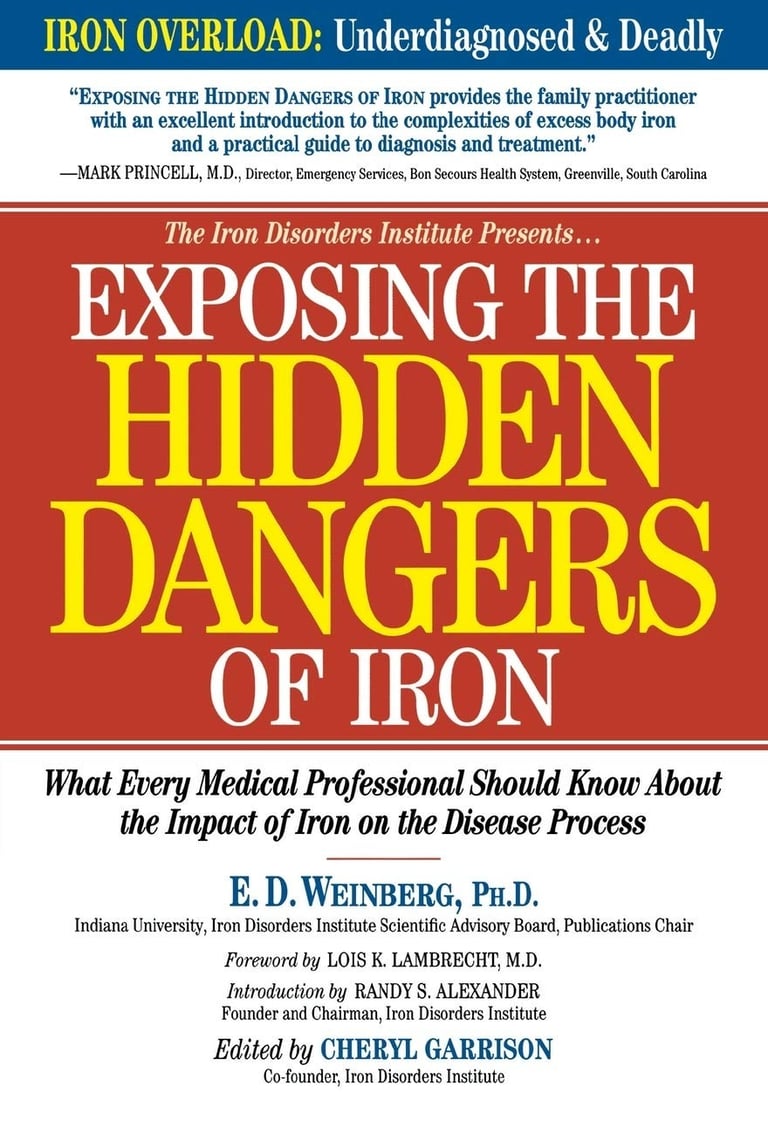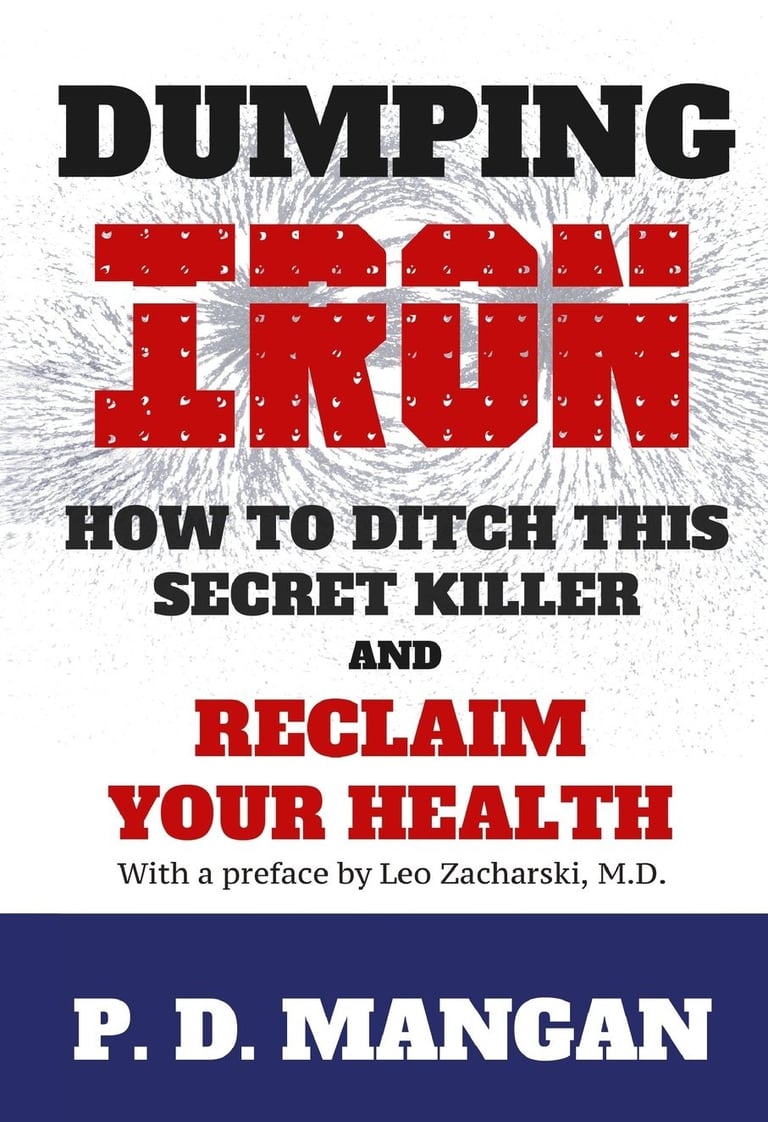WARNING: This website contains facts and opinions some may find offensive...
IRON




For more than seventy years, the North American public, as well as bureaucrats, have been enamored with the Popeye-the-sailor myth, namely, that ingested iron can somehow overcome fatigue and confer strength. During the same time period, however, numerous scientists and medical practitioners have learned to fear, rather than praise, iron. It is now overwhelmingly apparent that iron loading is a serious risk factor for scores of diseases—an array of cardiovascular disorders: endocrine problems such as diabetes and impotence; neurological ills such as Alzheimer’s and Parkinson’s: arthritis and osteoporosis, cancers of lung, colon, liver, and skin; nearly all bacterial and fungal infections; and shortened lifespan.
Iron is an essential trace element, but not a safe one. There are notable differences between iron levels found in the liver/spleen tissue and the iron levels found in the bone marrow. And therein lies the problem. The levels of iron found in the blood are not representative uniformly of the other two. All pathogens – Bacteria, Fungus, and Parasites – require iron for their existence, it’s noteworthy that so many people are being labeled “anemic.”
The inability to excrete iron is the primary problem—we can excrete only around 1.2 mg per day, no matter how much we absorb. Once iron has been absorbed in excess of the body’s need, it is very difficult to remove it. Much of the excess will be stored in the liver in ferritin. When ferritin is saturated, hemosiderin is released into the liver and can lead to all of the damaging effects of iron to liver cells.
The iron that we consume that is in excess of the amount we absorb is carried through the intestines and excreted in the feces. This iron can be very dangerous because it can exist in free form and generate oxygen radicals resulting in intestinal damage and colon cancer. Colon cancer has been induced in laboratory animals given large excesses of iron. Certain food factors can prevent this kind of damage—in particular phytates that are abundant in plant food.
It is known that ceruloplasmin (Cp) elevates in response to Inflammation. This is a biological certainty that has been encoded going back millennia of millennia. Big Pharma is applying misinformation strategy to Cp. It is what kept us kidnapped for 60 years on cholesterol. They want us to see Cp as the bad guy and do what we can to “lower” it.
This information is extremely important for people in advocacy groups such as arthritis, cancer, diabetes, heart, and neurodegenerative disorders. Unfortunately, clever marketing and bureaucratic intransigence have trumped science. It is extremely difficult, if not impossible, for the consumer to select processed foods that have not been deliberately adulterated with troublesome quantities of iron.
Although essential to life, iron is a very toxic metal. Most people are familiar with the highly publicized toxic metals such as lead, mercury, cadmium, manganese, aluminum, and arsenic. However, few people know that iron is responsible for a great deal more sickness and death than all of these other toxic metals combined!
We have been mesmerized into thinking that iron is somehow different from other metals, simply because it is essential.
Of particular importance is real vitamin-A, aka retinol, especially its ability to regulate iron metabolism and literally, dozens and dozens of other key metabolic pathways. Vit-A and hormone-D are biological antagonists. Iron is but one of many synthetic nutrients that are being added to our foods, not the least of which are many vitamins. And what we’re now learning is that synthetic vitamin-A (often in the form of Retinyl Palmitate), is also being routinely added to our foods – from orange juice to cereals, and many other processed foods.
Since 1941, the food industry has been adding inorganic iron (filings) to our wheat. In the early 1970s, this was increased by 50% thanks to the Food and Nutrition Board of the Institute of Medicine. As horrific as this is, iron is but one of many synthetic nutrients that are being added to our foods, not the least of which are many vitamins. And what we’re now learning is that synthetic vitamin-A (often in the form of Retinyl Palmitate), is also being routinely added to our foods – from orange juice to cereals, and many other processed foods. Well, yesterday, the insanity of these food “enrichment” practices got cranked up yet another notch.
Under healthy circumstances, iron is tightly bound to organic components. This binding is referred to as chelation. Chelation prevents iron from redox cycling. Hemoglobin and myoglobin are the most abundant mammalian hemoproteins, but there are also cytochromes and enzymes that utilize iron. Iron is present in iron-sulfur clusters that are important in electron transfer reactions. However, when present in excess, iron poses a threat to cells and tissues. Iron exists as ferrous iron. Fe(II), or ferric iron Fe(III). Free iron can be oxidized from ferrous iron to ferric iron and reduced from ferric iron to ferrous iron. This is known as redox cycling. When iron redox cycles, oxygen radicals are generated. the resulting superoxide and hydroxyl radicals damage cell structures.
Certain substances can inhibit iron absorption. The most commonly known inhibitors include:
Phytates: Found in whole grains and legumes, these compounds can bind to iron and reduce its bioavailability.
Tannins: Present in tea and coffee, tannins are polyphenolic compounds that can also impede iron absorption.
Coffee and common herbal teas impair iron absorption, which may help explain some of their benefits. 1 cup of coffee can prevent iron absorption by as much as 60%. The stronger the coffee, the more iron absorption is blocked. Eggs block iron absorption because they contain phosvitin, a protein compound that binds iron molecules together and prevents the body from absorbing iron from foods. Milk can also work as an inhibitor of iron absorption, potentially affecting your iron levels. The reason is calcium, the only known substance to inhibit the absorption of both non-heme and heme iron.
“Iron deficiency anemia” is not a nutritional deficiency disease. There are dozens of very diverse factors that can cause the conditions generally referred to as “iron deficiency anemia.” Chronic “iron deficiency anemia,” no matter what its origin may be, is a medical problem, not a nutritional problem.
High iron causes neuropathy. Iron overload can lead to cytotoxicity, and it is a risk factor for diabetic peripheral neuropathy. Iron blocks copper. And copper is needed by the nerves. Iron dyshomeostasis is an initial cause of several disorders, including genetic and sporadic neurodegenerative disorders. Critical Issues: However, very little has been done to investigate the physiological role of iron in peripheral nervous system.
High iron causes lung disease. Serum Hepcidin Levels Are Elevated In COPD And Are Associated With Increased Intracellular Iron In the Lung: http://www.atsjournals.org/doi/abs/10.1164/ajrccm-conference.2012.185.1_MeetingAbstracts.A6769
THE ROLE OF IRON IN CANCER:
Iron is an oxidant, as well as a nutrient for invading microbial and neoplastic cells. Excessive iron in specific tissues and cells promotes tumor growth. Idiopathic hemochromatosis is associated with a high risk of primary liver cancer. Elevated iron stores are linked to an increased risk of cancer and cancer mortality. Iron and colorectal cancer risk:" www.ncbi.nlm.nih.gov/pubmed/11396694
One of the dangers of iron is its ability to favor neoplastic cell growth. The metal is carcinogenic due to its catalytic effect on the formation of hydroxyl radicals, suppression of the activity of host defense cells and promotion of cancer cell multiplication. In both animals and humans, primary neoplasms develop at body sites of excessive iron deposits.
Iron, radiation, and cancer. Increased iron content of cells and tissue may increase the risk of cancer. In particular, high available iron status may increase the risk of a radiation-induced cancer. Iron The Double-Edged Sword. Iron encourages the formation of cancer-causing free radicals. Of course, the body needs a certain amount of iron for healthy blood cells. But beyond this rather small amount, iron becomes a dangerous substance, acting as a catalyst for the formation of free radicals. Because of this, higher amounts of iron in the blood mean higher cancer risk.
High iron causes cancer. Iron is a powerful stimulus for cancer growth, invasion and metastasis. www.ncbi.nlm.nih.gov/pubmed/8664805
The pioneer researcher in the role of iron in immunity believed that an excess of dietary iron contributed to the development of leukemia and lymphatic cancers. https://www.raypeat.com/articles/articles/iron-dangers.shtml
A relatively new piece in the breast cancer prevention puzzle is beginning to come to light. A study just published in the Journal of Clinical Biochemistry and Nutrition is the latest to point out an apparent link between elevated iron levels and an increased risk of breast cancer. Iron acts as a cancer-promoting agent by two separate yet synergistic mechanisms: 1) by producing "free radicals," and 2) by feeding cancer cells.
Iron is a primary carcinogen: Dietary Iron overload causes hepatocellular carcinoma in humans and laboratory animals.
Iron is a co-carcinogen: Iron activates many xenobiotics, resulting in carcinogenicity.
Iron is a synergistic carcinogen: Iron has a multiplicative carcinogenic effect in conjunction with alcohol, aflatoxin, hepatitis B, Hepatitis C, HIV, and papillomavirus.
Iron is a cumulative carcinogen: Iron accumulates with age; once excess iron is absorbed, the human body has no physiological mechanism for removing it.
Iron is a complete carcinogen: Iron is involved in all three phases of cancer development; initiation, promotion, and progression.
Because iron deficiency anemia is so common in the target population (menstruating women), public health officials have promoted the addition of iron to many of the most commonly consumed foods, i.e., nutrition supplements, flour, breads, pastas, and breakfast cereals. Despite this practice, iron deficiency anemia remains prevalent in the people who are supposed to be helped by the fortification programs.
In addition to its important function in carrying oxygen, iron is a critical element in numerous enzymes, where it promotes normal metabolism. Iron is also important in the iron-sulfur clusters that facilitate transport of electrons in mitochondria. However, iron deficiency is not known to affect levels of iron-sulfur clusters or enzymes, unless the deficiency is very severe.
The Recommended Dietary Allowance (RDA) for iron for women from 19 years to 50 years is 18 mg/day; for pregnant women it is 27 mg/day, and during lactation, 10 mg/day. The RDA for all other adults is 8 mg/day. The Tolerable Upper Intake Level (UL) for dietary iron is 45 mg/day.
According to the Food and Nutrition Board, one half of ingested iron comes from fortified foods, although this may be an under-estimation. Some cereals contain 24 mg iron per 1-cup serving. Most grain products have varying amounts of iron added—this means virtually all flour, all pastas, all bread, all cereals. Iron supplements commonly sold over the counter contain from 15 mg to around 60 mg iron according to the label-recommended daily intake. It is easy to see how millions of people in North America are daily consuming more than the UL for iron. Companies are allowed to fortify foods with more than the Dietary Reference Intakes (DRIs) in a single serving.
Studies have demonstrated that we ordinarily absorb around 15% of the iron that we consume. A person consuming a daily diet containing approximately 15 mg of iron are excreted each day. Children are reported to absorb less iron than adults—around 10%. Pregnant women absorb more—around 17%.
Although only a small percentage of the iron that we consume is absorbed, many factors affect iron absorption. For instance, heme iron is very efficiently absorbed. High heme iron consumption has been correlated with the development of breast cancer. Also, iron absorption can be increased considerably when it is held in the iron 2+ form as it is in the supplements that have combined iron with vitamin C. Iron/vitamin C supplements that have combined iron with vitamin C. Iron/vitamin C supplements containing far more than the daily UL for iron are freely sold in spite of their clear danger to human health. Viton-C, for example, contains around 60 mg iron in a single pill as the recommended daily intake. These supplements are very likely the most dangerous “nutritional” supplements ever conceived. Beware!
IRON TOXICITY
Under healthy circumstances, iron is tightly bound to organic components. This binding is referred to as chelation. Chelation prevents iron from redox cycling. Hemoglobin and myoglobin are the two most abundant mammalian hemoproteins, but there are also cytochromes and enzymes that utilize iron. Iron is present in iron-sulfur clusters that are important in electron transfer reactions.
However, when present in excess, iron poses a threat to cells and tissues. Iron exists as ferrous iron, Fe(II), or ferric iron. Fe(III). Free iron can be oxidized from ferrous iron to ferric iron and reduced from ferric iron to ferrous iron. This is known as redox cycling. When iron redox cycles, oxygen radicals are generated. The resulting superoxide and hydroxyl radicals damage cell structure.
IRON EXCESS WORSENS CHRONIC ILLNESS
Iron can accumulate in free form in any body tissue under conditions of iron overload. The most dangerous feature of iron is that it is attracted to, and deposits in, damaged tissue. Thus, the neurofibrillary tangles of Alzheimer’s, the substantia nigra of Parkinson’s, the atherosclerotic plaques of coronary artery disease, the inflamed joints of arthritis, the pancreatic islet cells of adult-onset diabetics all display increased levels of free iron. There is no way to tell whether the iron initiates the disease or if the diseased tissue attracts the iron which then exacerbates the condition. But either way, free iron in any body tissue is dangerous.
Excess iron in your heart affects the heart's ability to circulate enough blood for your body's needs. This is called congestive heart failure. Hemochromatosis can also cause abnormal heart rhythms (arrhythmias) https://www.webmd.com/heart-disease/news/20001025/too-much-iron-may-lead-to-heart-attack. As the level of iron goes up in your bloodstream, so does your risk for heart attack and stroke.
Nearly every individual in North America displays some manifestation of iron poisoning with advancing age. Here is a brief list:
· NEUROLOGICAL DEGENERATIONS: Parkinson’s & Alzheimer’s
- The brain is a major target for excess iron.
- Accumulation of iron in brain tissue either causes, or contributes to, neurological diseases such as Parkinsonism and Alzheimer’s disease.
· CANCER: Iron is a powerful carcinogen.
- Excess iron is a well-documented cause of hepatocellular carcinoma.
- Elevated levels of iron predispose to breast cancer.
- Animals fed iron excesses develop colon cancer, believed to be the result of free radical generation by unabsorbed iron.
· HEART DISEASE:
- Excess iron accumulates in the heart and arteries.
- Free iron is bound in heart and arteries may provoke arterial damage.
· DIABETES:
- In hereditary hemochromatosis, excess iron accumulates in the pancreas where it disrupts insulin secretion and causes adult-onset diabetes.
- Iron deposits are found in pancreatic islet cells in people with adult-onset diabetes.
· JOINT INFLAMMATION/ARTHRITIS: Iron is found in free form in arthritic joints.
· OSTEOPOROSIS: People with transfusion siderosis develop osteoporosis at a very young age; iron accumulation in bone causes osteopenia and osteoporosis.
· PITUITARY FUNCTION: People with hereditary iron overload may have “hypogonadotrophic hypogonadism”—infertility due to iron accumulation in the pituitary gland.
· SPERM DAMAGE: Iron overload diseases are uniformly associated with sperm damage.
· SEXUAL DYSFUNCTION:
- Hypogonadotrophic hypogonadism & infertility.
- Sperm and egg DNA damage.
· EYE DISEASES: Age related macular degeneration (AMD).
· KIDNEY DAMAGE: Hypertension.
· HEARING LOSS.
· CEREBROVASCULAR ACCIDENTS: stroke.




Dumping Iron: How to Ditch This Secret Killer and Reclaim Your Health Paperback – March 17, 2016


Contact Us!
TuberoseHealing@protonmail.com
(727) 233-2978
Subscribe to our website.

